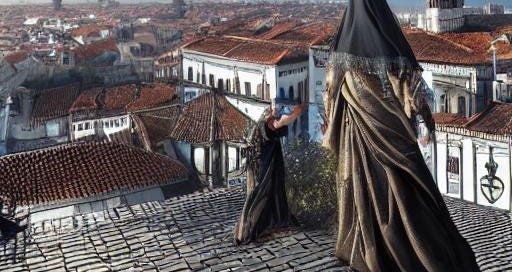Coca is a creature from the portuguese folklore who gives fear a form. Even though it lacks a precise physical description, varying a lot from place to place, people would know enough to create a mental picture. Coca has two main descriptions: one of a ghost, another of a dragon. The first is a creature who punishes children, the second satan in aninal form.
Coca, the Ghost
According to Father Celso Tavares, Coca is a creature who punishes dishobedient children, a sort of ghost who terrified boys and girls especially at night. It seems parents would even sing a song to their children to drive Coca away1:
“Vai-te Côca, vai-te Côca,
Para cima do telhado:
Deixa o menino dormir
um soninho descansado.”
“Go away Côca, go away Côca,
Up to the roof:
Let the child sleep
A restfull sleep.”
He also gives a rare description of how Coca was imagined by the population, “a fantastical being, a soul from the other world, imitated in childhood play by covering the head, leaving uncovered solely the shining eyes”2. In the song there is a reference to roofs, because Coca would position herself in the roof waiting for a misbeahaviour from the child, in order to snatch them away. It is said that the portuguese expression “estar à coca” (lay waiting) is a reference to this creature.
Coca, the Dragon
In the town of Monção in Minho, legend tells of a dragon, named Coca, that lived under the waters of Minho River and one day took a girl away, and St.George, angered by such evil deed, killed the dragon and saved the girl3. This mythical event is celebrated to this day on Corpus Christi, by building a Coca that will fight an actor playing St. George. The audience chooses the side of Coca or St. George, but each year the winner is still the Saint.
Galiza has a similar legend. According to the legend of Galiza, in the 16th century in the mouth of Alvedoz river some boys saw Coca, the dragon coming out of the waters, and moving in a way as if it was looking for something. Then it saw a young woman, and grabing her by the waste took her away forever. Since that year, every year in Corpus Christi, the population would give a girl to the dragon. But the young men decided to stop this atrocious behaviour, and save all the village girls. They hid, and when Coca emerged from the waters they killed it4. This beautiful legend is also celebrated to this day, with a similation of the fight between Coca and the boys.
This folkloric being was taken to Brazil by the portuguese colonizers and was transformed into “Cuca”. This new being “Cuca” was reshaped into a witch (maybe influenced by the ghost version of Cuca) with an alligator head (the dragon was changed into an alligator, a local animalwith similar features), who abducts children. Cuca retains the role of scaring boys and girls.
Even if today parents no longer tell scary stories to their children and many if not most young people do not know Coca and other folkloric beings, the dragon Coca is still celebrated each year, and in 2016 “Bestiário Tradicional Português”5, a book about portuguese folkloric beings, was published. These stories are also in the memory of the older generation whose obligation is to pass it on to those who come after.
TAVARES, Celso, Vestígios Pré-históricos de Bésteiros - A Laja das Côcas, Revista Beira Alta, Volume V, Fascículo I, 1946
TAVARES, Celso, Vestígios Pré-históricos de Bésteiros - A Laja das Côcas, Revista Beira Alta, Volume V, Fascículo I, 1946
https://www.radiovaledominho.com/galiza-esta-vila-tal-como-moncao-tambem-tem-uma-coca-conhece-a-lenda
https://galiciaencantada.com/lenda.asp?cat=6&id=1489
VALENTE, Nuno Matos e PEREIRA, Natacha Costa, Bestiário Tradicional Português - as criaturas fantásticas do imaginário popular, Edições Escafandro, 2016, ISBN: 9789899966901





